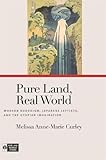Pure Land, Real World : Modern Buddhism, Japanese Leftists, and the Utopian Imagination / Melissa Anne-Marie Curley; ed. by Richard K. Payne.
Material type: TextSeries: Pure Land Buddhist StudiesPublisher: Honolulu : University of Hawaii Press, [2017]Copyright date: ©2017Description: 1 online resource (280 p.)Content type:
TextSeries: Pure Land Buddhist StudiesPublisher: Honolulu : University of Hawaii Press, [2017]Copyright date: ©2017Description: 1 online resource (280 p.)Content type: - 9780824857752
- 9780824857783
- 294.3/9260952 23
- BQ8512.9.J3
- online - DeGruyter
- Issued also in print.
| Item type | Current library | Call number | URL | Status | Notes | Barcode | |
|---|---|---|---|---|---|---|---|
 eBook
eBook
|
Biblioteca "Angelicum" Pont. Univ. S.Tommaso d'Aquino Nuvola online | online - DeGruyter (Browse shelf(Opens below)) | Online access | Not for loan (Accesso limitato) | Accesso per gli utenti autorizzati / Access for authorized users | (dgr)9780824857783 |
Frontmatter -- Contents -- Series Editor's Preface -- Acknowledgments -- Abbreviations -- Introduction -- Chapter One. The Land in Pure Land -- Chapter Two. The Modern Tradition -- Chapter Three. Special Marxist, Special Buddhist -- Chapter Four. Pure Land for the People -- Chapter Five. Man without a Hometown -- Epilogue. "Let Us Read Shinran, Young People!" -- Notes -- Works Cited -- Index -- About the Author
restricted access online access with authorization star
http://purl.org/coar/access_right/c_16ec
For close to a thousand years Amida's Pure Land, a paradise of perfect ease and equality, was the most powerful image of shared happiness circulating in the Japanese imagination. In the late nineteenth century, some Buddhist thinkers sought to reinterpret the Pure Land in ways that would allow it speak to modern Japan. Their efforts succeeded in ways they could not have predicted. During the war years, economist Kawakami Hajime, philosopher Miki Kiyoshi, and historian Ienaga Saburō-left-leaning thinkers with no special training in doctrinal studies and no strong connection to any Buddhist institution-seized upon modernized images of Shinran in exile and a transcendent Western Paradise to resist the demands of a state that was bearing down on its citizens with increasing force. Pure Land, Real World treats the religious thought of these three major figures in English for the first time.Kawakami turned to religion after being imprisoned for his involvement with the Japanese Communist Party, borrowing the Shinshū image of the two truths to assert that Buddhist law and Marxist social science should reinforce each other, like the two wings of a bird. Miki, a member of the Kyoto School who went from prison to the crown prince's think tank and back again, identified Shinran's religion as belonging to the proletariat: For him, following Shinran and working toward building a buddha land on earth were akin to realizing social revolution. And Ienaga's understanding of the Pure Land-as the crystallization of a logic of negation that undermined every real power structure-fueled his battle against the state censorship system, just as he believed it had enabled Shinran to confront the world's suffering head on. Such readings of the Pure Land tradition are idiosyncratic-perhaps even heretical-but they hum with the same vibrancy that characterized medieval Pure Land belief. Innovative and refreshingly accessible, Pure Land, Real World shows that the Pure Land tradition informed twentieth-century Japanese thought in profound and surprising ways and suggests that it might do the same for twenty-first-century thinkers. The critical power of Pure Land utopianism has yet to be exhausted.
Issued also in print.
Mode of access: Internet via World Wide Web.
In English.
Description based on online resource; title from PDF title page (publisher's Web site, viewed 02. Mrz 2022)


